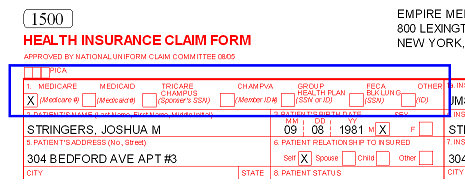 Case
Type
Case
Type
It is important that
you begin entering in patient information by first selecting an appropriate case
type.
Case type does
three very important things inside your QuickPractice software.
- The selected case type maps to BOX 1 on your CM'S - 1500 forms (see below).
Although a
number of default case types are coded into the QuickPractice software, you may
also add your own
case types if
you do not see one that is appropriate. Using a customized case-type will select
"other" for BOX 1 on the CMS01500 form.
To
Add:
1. From the case type drop down menu, click Add New instead of selecting a case type. The Add window will appear.
2. Specify the type, by choosing either "insurance" or "non insurance" (to flag charges accordingly).
3. Type in a description for the case type you want to add.
4. Enter the default coverage that will be used whenever this case type is used.
5. Click OK to finish.
